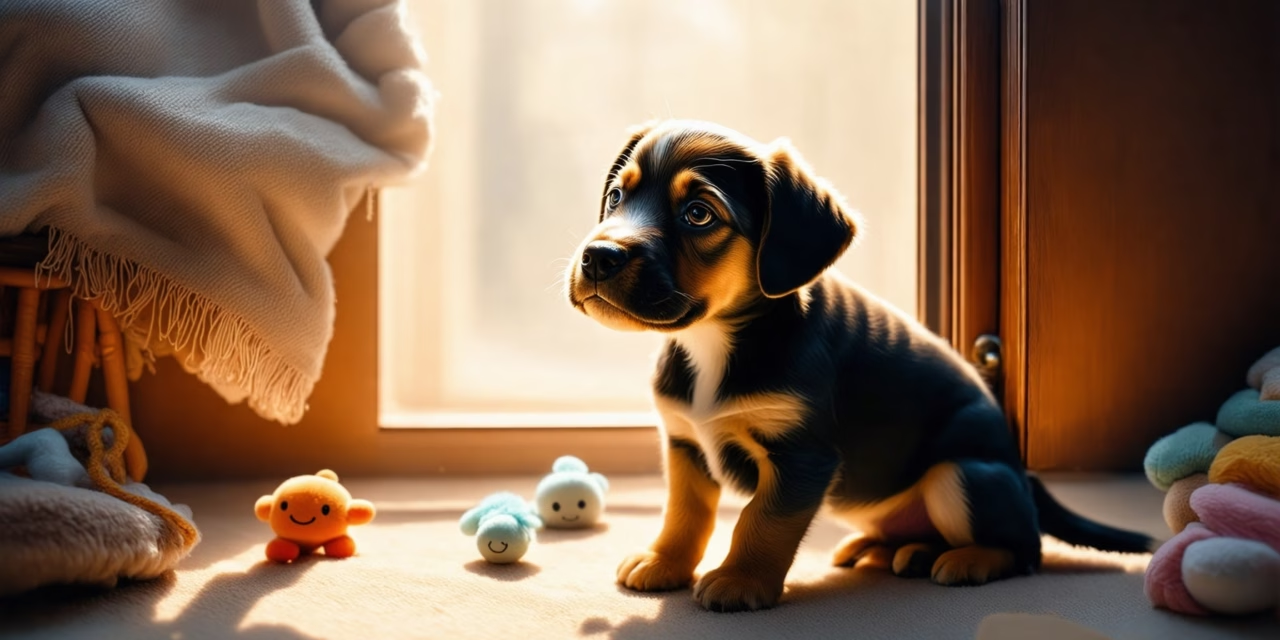Key Takeaways
- Understanding puppy separation anxiety is crucial for effective management, including recognizing symptoms like excessive barking and destructive behavior.
- Implement gradual desensitization techniques by leaving your puppy alone for short periods to build their confidence over time.
- Create a safe space with comforting items to help soothe your puppy’s anxiety when you’re away.
- Utilize positive reinforcement to reward calm behavior, fostering a positive association with being alone.
- Engage your puppy with interactive toys to keep them mentally stimulated and distracted during your absences.
- Establish a consistent routine for feeding and playtime to reduce anxiety through predictability.
- If symptoms persist, seek professional help from a veterinarian or certified animal behaviorist for tailored advice and potential treatments.
Welcome to our comprehensive guide on puppy separation anxiety, a common yet often misunderstood issue that many dog owners face. In this article, we will delve into effective strategies for managing this condition, providing you with valuable insights on understanding puppy separation anxiety, recognizing its symptoms, and identifying the causes and triggers that can exacerbate the issue. We will explore proven training techniques, discuss treatment options, and highlight what not to do when dealing with separation anxiety in dogs. Additionally, we will cover the nuances of crate training and how it relates to separation anxiety, ensuring you have a well-rounded understanding of how to help dogs with separation anxiety. By the end of this article, you will be equipped with the knowledge and tools necessary to effectively address puppy separation anxiety and foster a more comfortable environment for your furry friend.
Understanding Puppy Separation Anxiety
Puppy separation anxiety is a common issue that many pet owners face. It occurs when a puppy becomes overly attached to their owner and experiences distress when left alone. This anxiety can manifest in various ways, including excessive barking, destructive behavior, and even house soiling. Understanding how to break separation anxiety in puppies is crucial for fostering a healthy, happy relationship between you and your furry friend.
How do you break separation anxiety in puppies?
To effectively break separation anxiety in puppies, consider the following comprehensive strategies:
- Gradual Desensitization: Start by leaving your puppy alone for short periods, gradually increasing the duration. This helps them learn that you will return and reduces anxiety over time.
- Create a Safe Space: Designate a comfortable area for your puppy with their bed, toys, and a piece of your clothing. This familiar environment can help soothe them when you are away.
- Positive Reinforcement: Reward your puppy with treats and praise when they remain calm during your departures and arrivals. This reinforces the idea that being alone is a positive experience.
- Interactive Toys: Provide engaging toys that can keep your puppy occupied while you are away. Puzzle toys filled with treats can stimulate their mind and distract them from your absence.
- Routine Establishment: Maintain a consistent daily routine for feeding, walks, and playtime. Predictability can help reduce anxiety as your puppy learns what to expect.
- Training Commands: Teach basic commands such as “stay” and “leave it.” This not only provides mental stimulation but also helps establish boundaries and trust between you and your puppy.
- Professional Help: If your puppy’s anxiety persists, consider consulting a veterinarian or a certified animal behaviorist. They can provide tailored advice and may recommend behavioral therapy or medication if necessary.
- Socialization: Expose your puppy to various environments, people, and other pets. This helps build their confidence and reduces anxiety in unfamiliar situations.
- Calming Aids: Explore natural calming aids such as pheromone diffusers or anxiety wraps. These can provide additional comfort to your puppy during stressful times.
For further reading on effective strategies for managing puppy separation anxiety, refer to resources from the American Kennel Club and the ASPCA, which provide valuable insights and research-backed methods for pet owners.
Puppy separation anxiety symptoms
Recognizing the symptoms of separation anxiety in puppies is essential for timely intervention. Common signs include:
- Excessive barking or howling when left alone
- Destructive behavior, such as chewing furniture or digging
- House soiling despite being house-trained
- Pacing or restlessness when you prepare to leave
- Clinginess or following you around the house
- Loss of appetite or refusal to eat when alone
Understanding these symptoms can help you identify and address separation anxiety in dogs early on, ensuring a smoother transition for both you and your puppy. For more insights, you can explore discussions on dogs separation anxiety reddit for shared experiences and advice from fellow pet owners.

Causes and Triggers of Separation Anxiety in Dogs
Understanding the causes and triggers of separation anxiety in dogs is crucial for effective management and treatment. Various factors contribute to this condition, and recognizing them can help pet owners take proactive steps to alleviate their puppy’s distress.
At What Age Do Puppies Stop Having Separation Anxiety?
Puppies do not have a specific age at which they stop experiencing separation anxiety. Instead, the severity of separation anxiety can vary widely among individual dogs and may decrease over time with proper training and socialization. Here are key points to consider:
- Understanding Separation Anxiety: Separation anxiety is a behavioral condition where a puppy exhibits distress when left alone. Symptoms can include barking, whining, destructive behavior, and attempts to escape.
- Training and Socialization: Consistent training and socialization are essential. Introducing your puppy to short periods of alone time can help them gradually adjust. Positive reinforcement techniques, such as rewarding calm behavior, can reinforce their comfort with solitude.
- Individual Variations: Factors such as breed, temperament, and past experiences play a significant role in how a puppy copes with being alone. For example, breeds known for their strong attachment to humans may experience more intense anxiety.
- Long-term Approach: Addressing separation anxiety is often a gradual process. According to the American Kennel Club, it can take weeks or even months for a puppy to feel secure when left alone.
- Crate Training: Crate training can create a safe space for your puppy. It is important to make the crate a positive environment, associating it with treats and comfort.
- Gradual Desensitization: Start by leaving your puppy alone for short periods and gradually increase the duration. This helps them build confidence and reduces anxiety over time.
- Exercise and Enrichment: Ensure your puppy receives adequate physical exercise and mental stimulation before being left alone. Engaging toys and puzzles can keep them occupied.
- Consistency: Establishing a consistent routine can help your puppy feel more secure. Predictability in their daily schedule fosters a sense of stability.
- Professional Help: If your puppy’s separation anxiety is severe, consulting a certified professional dog trainer or a veterinary behaviorist may be necessary. The ASPCA emphasizes the importance of professional guidance in severe cases.
Signs of Separation Anxiety in Dogs
Recognizing the signs of separation anxiety in dogs is essential for timely intervention. Common symptoms include:
- Barking and Whining: Excessive vocalization when left alone is a primary indicator of distress.
- Destructive Behavior: Chewing furniture, scratching doors, or digging can signal anxiety.
- Attempts to Escape: Dogs may try to escape their environment, which can lead to injuries.
- Excessive Greeting: Dogs with separation anxiety may display overly excited behavior when their owners return.
- House Soiling: Inappropriate elimination can occur due to stress when left alone.
- Restlessness: Dogs may pace or exhibit signs of agitation when they sense their owner is about to leave.
Understanding these symptoms can help you identify if your puppy is struggling with separation anxiety. Early recognition allows for effective strategies to be implemented, ensuring a happier and healthier pet.
Effective Training Techniques for Separation Anxiety
Training your puppy to overcome separation anxiety is a crucial step in ensuring their well-being and your peace of mind. By employing effective training techniques, you can help your puppy feel more secure when left alone, reducing the symptoms of separation anxiety in puppies. Here are some proven strategies to consider:
How to Train a Dog with Separation Anxiety?
- Start Small: Begin training by leaving your dog alone for very short periods (e.g., 5-10 minutes) while you are still in the room. This helps them acclimate to your absence without feeling overwhelmed.
- Increase Time Gradually: As your dog becomes more comfortable, gradually increase the duration of your absences. This step-by-step approach helps build their confidence and reduces anxiety over time.
- Consistency is Key: Maintain a consistent routine and schedule. Predictability can significantly help reduce anxiety in dogs, as they learn what to expect.
- Make it a Routine: Establish a daily routine that includes activities like walks, playtime, and training sessions. Regular engagement can help your dog feel more secure and relaxed.
- Positive Reinforcement: Reward your dog for calm behavior when left alone. Use treats, praise, or toys to reinforce positive actions, which encourages them to associate your departures with good experiences.
- Create a Relaxing Environment: Ensure your dog has a comfortable and safe space to relax when you are not around. A crate can be beneficial if introduced positively, serving as a cozy haven.
- Engage their Mind: Provide mentally stimulating toys, such as puzzle toys or food-dispensing toys, to keep your dog entertained and engaged during your absence. This mental engagement can reduce feelings of loneliness.
- Exercise: Regular physical activity is crucial for reducing anxiety. Take your dog for a walk or engage in interactive play before you leave to help burn off excess energy.
- Reduce Fussing: Avoid making a big deal out of your comings and goings. Minimize excitement during departures and arrivals, and only offer attention when your dog is calm to help them understand that your absence is normal.
- Consider Professional Help: If managing your dog’s separation anxiety proves challenging, consult a certified professional dog trainer or a veterinary behaviorist. They can provide tailored strategies and support.
- Calming Supplements: In some cases, veterinarians may recommend calming supplements or medications to help manage anxiety. Always consult with a veterinarian before starting any new treatment.
For additional support, consider exploring resources on ASPCA for pet care and anxiety resources.
Separation Anxiety Dogs Training
Training for separation anxiety in dogs requires patience and understanding. Here are some focused techniques to enhance your training efforts:
- Desensitization: Gradually expose your dog to being alone for longer periods. Start with brief absences and slowly extend the time as they become more comfortable.
- Counter-Conditioning: Change your dog’s emotional response to being alone by associating your departures with positive experiences, such as giving them a special toy or treat that they only receive when you leave.
- Use of Toys: Invest in toys for separation anxiety in dogs that can keep them occupied while you are away. These toys can help distract them and reduce feelings of loneliness.
- Training Sessions: Incorporate short training sessions into your daily routine to reinforce positive behaviors and build your dog’s confidence.
For more insights on dog separation anxiety training, consider visiting the American Kennel Club for dog training resources.
Treatment Options for Puppy Separation Anxiety
Addressing puppy separation anxiety requires a multifaceted approach that combines behavioral training, environmental adjustments, and sometimes professional intervention. Understanding the various puppy separation anxiety treatment options available can help you create a tailored plan that suits your puppy’s specific needs.
Puppy Separation Anxiety Treatment
Effective treatment for separation anxiety in puppies often involves a combination of training techniques and supportive measures. Here are some key strategies:
- Desensitization: Gradually acclimate your puppy to being alone by starting with short departures and slowly increasing the duration. This helps your puppy learn that being alone is safe and temporary.
- Counter-conditioning: Pair your departures with positive experiences, such as giving your puppy a special treat or toy that they only receive when you leave. This can help change their emotional response to your absence.
- Interactive Toys: Utilize toys for separation anxiety in dogs, such as puzzle feeders or treat-dispensing toys, to keep your puppy engaged while you are away. This can reduce feelings of boredom and anxiety.
- Crate Training: Properly crate training your puppy can provide them with a safe space. Ensure that the crate is a positive environment, not a place of punishment. Gradual introduction to the crate can help alleviate anxiety.
- Professional Help: If your puppy’s anxiety is severe, consider consulting a veterinarian or a certified dog trainer specializing in separation anxiety dogs training. They can provide tailored strategies and, if necessary, discuss medication options.
How to Treat Separation Anxiety in Puppies
To effectively treat separation anxiety in puppies, it’s essential to implement consistent training and support strategies:
- Routine Establishment: Create a consistent daily routine for your puppy, including feeding, playtime, and training sessions. Predictability can help reduce anxiety.
- Positive Reinforcement: Use positive reinforcement techniques to reward calm behavior when you leave and return home. This encourages your puppy to associate your departures with positive outcomes.
- Gradual Alone Time: Start by leaving your puppy alone for just a few minutes and gradually increase the time as they become more comfortable. Monitor their behavior during this process.
- Calming Aids: Consider using calming products, such as anxiety wraps or pheromone diffusers, which can help soothe your puppy during stressful times.
- Engagement Before Departure: Engage your puppy in play or training before you leave to help expend some of their energy and reduce anxiety levels.
For more insights on managing puppy separation anxiety, you can explore resources from the American Kennel Club and the ASPCA for additional support and guidance.

What Not to Do with Dog Separation Anxiety
When addressing puppy separation anxiety, it’s essential to understand what actions can inadvertently worsen the situation. Avoiding certain behaviors can significantly aid in your puppy’s recovery and help them feel more secure when left alone.
What Not to Do with Dog Separation Anxiety?
1. **Ignoring the Problem**: Simply ignoring your puppy’s anxiety can exacerbate their distress. Instead, it’s crucial to acknowledge their feelings and take proactive steps to help them cope. Gradual desensitization and positive reinforcement are effective methods to alleviate their fears.
2. **Punishing Your Puppy**: Punishment for anxious behaviors, such as barking or whining, can lead to increased anxiety and confusion. Instead, focus on rewarding calm behavior and providing comfort during your departures.
3. **Making a Big Deal Out of Departures and Arrivals**: Overly emotional goodbyes or greetings can heighten anxiety. Keep your departures low-key to help your puppy understand that being alone is a normal part of their routine.
4. **Leaving Your Puppy Alone for Extended Periods**: Sudden long absences can trigger anxiety. Start with short periods of separation and gradually increase the time as your puppy becomes more comfortable being alone.
5. **Using Crates as a Punishment**: While crate training can be beneficial, using the crate as a form of punishment can create negative associations. Ensure that the crate is a safe and comforting space for your puppy.
6. **Neglecting to Provide Comfort Items**: Not offering toys or items with your scent can leave your puppy feeling insecure. Providing familiar items can help soothe their anxiety when you’re away.
By avoiding these common pitfalls, you can create a more supportive environment for your puppy, helping them overcome separation anxiety effectively.
How to Deal with Separation Anxiety in Dogs
To effectively manage separation anxiety in dogs, consider the following strategies:
1. **Establish a Routine**: Consistency in feeding, walks, and playtime can provide a sense of security for your puppy. A predictable schedule helps them feel more at ease.
2. **Gradual Desensitization**: Begin by leaving your puppy alone for short periods, gradually increasing the duration. This method helps them learn that being alone is not a threat.
3. **Positive Reinforcement**: Reward your puppy with treats and praise when they remain calm during your departures and arrivals. This reinforces the idea that being alone can lead to positive outcomes.
4. **Comfort Items**: Provide your puppy with a favorite toy or an item with your scent. Familiar scents can reduce stress in dogs.
5. **Professional Help**: If your puppy’s anxiety is severe, consider consulting a veterinarian or a certified animal behaviorist. They may recommend behavioral therapy or, in some cases, medication to help manage anxiety.
6. **Avoid Punishment**: Ignoring your puppy when you leave may seem like a solution, but it can lead to increased anxiety and confusion. Instead, a calm and reassuring departure can help ease their fears.
By implementing these strategies, you can effectively address separation anxiety in dogs and create a more comfortable environment for your puppy. For additional insights, you can explore resources from the American Kennel Club and the ASPCA.
Managing Crate Training and Separation Anxiety
Crate training can be an effective method for managing puppy separation anxiety, but it requires a careful approach to ensure your puppy feels safe and secure. Understanding how to balance crate time with comfort is crucial for alleviating anxiety.
How long to let a puppy cry in a crate?
When crate training a puppy, it’s essential to balance allowing them to cry and ensuring their comfort and safety. Here’s a comprehensive guide on how long to let a puppy cry in a crate:
- Self-Soothing: Allowing a puppy to cry for short periods can help them learn to self-soothe and develop independence. Start with a few minutes of crying before intervening.
- Attention-Seeking Behavior: If you respond immediately to whining, the puppy may learn to cry for attention. It’s crucial to wait for a moment of quiet before letting them out.
- Gradual Desensitization: Gradually increase the time your puppy spends in the crate. Start with short intervals and slowly extend them as the puppy becomes more comfortable.
- Crying Duration:
- Short Crying (1-5 minutes): This is generally acceptable and can be ignored to encourage self-soothing.
- Moderate Crying (5-15 minutes): Monitor the situation; if the puppy settles down, it’s best to wait it out.
- Prolonged Crying (30+ minutes): If the crying persists beyond 30 minutes, it may indicate distress or separation anxiety. Check on the puppy to ensure they are safe and comfortable.
- Signs of Distress: Pay attention to the type of crying. High-pitched, desperate cries may signal a need for immediate attention, such as a potty break or discomfort.
- Unusual Barking: Persistent or unusual barking could indicate that something is wrong. Assess the situation to determine if the puppy needs assistance.
- Meeting Basic Needs: Ensure the puppy has been taken out for a bathroom break, has access to food and water, and is not in distress before crating.
- Creating a Positive Crate Environment: Make the crate a welcoming space by introducing it gradually, feeding the puppy in the crate, and providing comfortable bedding and toys.
- Positive Associations: Avoid leaving the puppy in the crate for extended periods initially. Use treats and praise to create a positive association with the crate.
- Scheduled Breaks: Provide regular potty breaks and exercise outside the crate to help the puppy adjust.
- Calm Departures and Arrivals: Keep your actions low-key when crating or letting the puppy out to prevent anxiety.
For further reading, consult resources such as the American Kennel Club and ASPCA, which provide expert advice on crate training and puppy behavior.
Crate training dog separation anxiety
Crate training can significantly alleviate separation anxiety in dogs when done correctly. Here are some effective strategies:
- Start Early: Introduce your puppy to the crate at a young age to help them associate it with safety and comfort.
- Short Sessions: Begin with short periods in the crate while you are home. Gradually increase the duration as your puppy becomes more comfortable.
- Use Toys for Distraction: Provide toys for separation anxiety in dogs, such as chew toys or interactive puzzles, to keep them engaged while in the crate.
- Positive Reinforcement: Reward your puppy with treats and praise when they enter the crate willingly, reinforcing the behavior.
- Consistency is Key: Maintain a consistent schedule for crating and potty breaks to help your puppy feel secure.
For more insights on managing separation anxiety, you can explore our blog for additional tips and resources.
Additional Resources and Support
Puppy separation anxiety reddit
Online communities, such as Reddit’s r/dogs, provide valuable insights and support for pet owners dealing with puppy separation anxiety. These forums allow users to share experiences, tips, and resources that can help in managing separation anxiety in dogs. Engaging with others who face similar challenges can offer emotional support and practical advice on how to help dogs with separation anxiety.
Curing dog separation anxiety quickly
While there is no one-size-fits-all solution for curing dog separation anxiety, several strategies can expedite the process. Here are some effective methods:
- Gradual Desensitization: Slowly increase the time your puppy spends alone, starting with just a few minutes and gradually extending the duration. This helps them adjust to being alone without feeling overwhelmed.
- Positive Reinforcement: Use treats and praise to reward your puppy for calm behavior when you leave and return home. This builds a positive association with your departures and arrivals.
- Interactive Toys: Provide toys for separation anxiety in dogs, such as puzzle toys or treat-dispensing toys, to keep them engaged while you are away. This can help distract them and reduce feelings of anxiety.
- Professional Help: If your puppy’s anxiety is severe, consider consulting a veterinarian or a certified dog trainer specializing in separation anxiety dogs training. They can provide tailored strategies and, if necessary, discuss medication options.
For more in-depth information on puppy separation anxiety treatment, you can explore resources from the ASPCA and the American Kennel Club.













